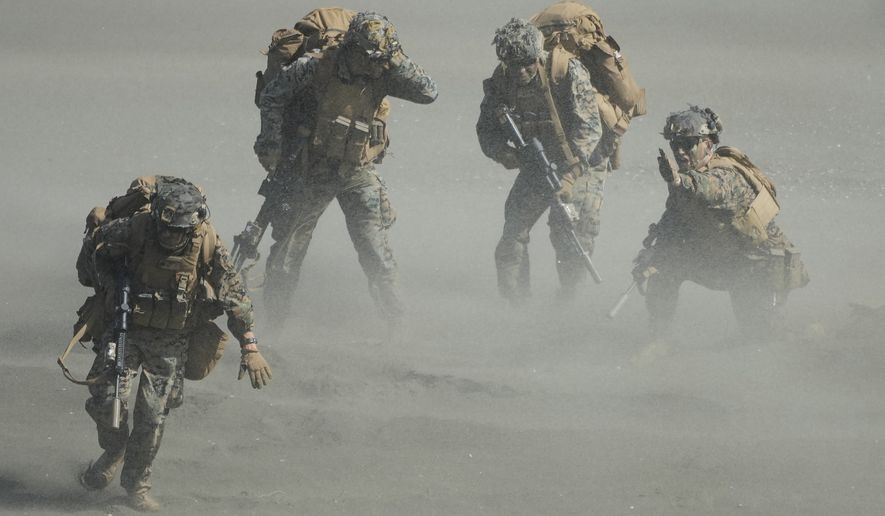The Supreme Court justices were sparring last month over the use of racial preferences in school admissions policies, and the Biden administration’s top litigator kept coming back to one point: Think of the troops.
Solicitor General Elizabeth Prelogar said schools must enroll diverse student bodies so the nation’s military will have the kinds of leaders it needs to field, train and take into combat the world’s best fighting force.
“It is a critical national security imperative to attain diversity within the officer corps,” she told the justices. “And, at present, it’s not possible to achieve that diversity without race-conscious admissions, including at the nation’s service academies.”
At the academies and other schools with officer candidate training programs, she said, taking away affirmative action would make the country less secure.
The cases before the justices involved the admissions policies at Harvard University and the University of North Carolina, which ask applicants about their race. The schools acknowledge that they use the answers to try to increase the numbers of Black, Hispanic and American Indian students.
A majority of the court appeared to be skeptical about preferences, but Ms. Prelogar’s argument about the military gave them pause.
Justice Samuel A. Alito Jr. called it “something that we have to take very seriously.”
“You represent the entire executive branch, including the military, and we have to presume that you are reflecting the views of the military,” he told the solicitor general.
The argument about diversity and the military stretches back decades. The services have been working to become more inclusive to reflect the general civilian population.
A 2020 Department of Defense report found that the representation of Hispanic and Black service members was higher in the military than it was in the civilian population, but the data showed those minorities still weren’t well-represented within leadership and officer roles.
Ms. Prelogar told the justices that the academies have tried to attract qualified minority students by increasing outreach, allowing more nominations from certain congressional districts and using other proxies such as socioeconomics.
“West Point discovered that that would actually increase the number of White men at the academy,” she said. “And other race-neutral alternatives just don’t work in this context for the service academies.”
Chief Justice John G. Roberts Jr. asked Ms. Prelogar whether the academies should have a special policy.
“I would have thought that you might want to distinguish yourself in order to preserve arguments that are particularly applicable, if there are such arguments, to the service academies, rather than take the position here, which is you’re going to be bound by whatever we say with respect to the other universities,” he said.
The solicitor general did not take Chief Justice Roberts’ invitation. She said the national security argument for affirmative action goes beyond the academies.
She said more officers come from ROTC programs at regular schools than the academies, so they need diversity.
Court watchers said Chief Justice Roberts might have been trying to signal a potential middle ground and had legal justification for that.
“There is precedent for a more relaxed standard — a more pro-governmental standard — when you’re dealing with national security matters and governmental affairs,” said Rod Smolla, president of Vermont Law and Graduate School. “There is this danger of this kind of two-class military.”
Adam Feldman, creator of the Empirical SCOTUS blog, said Chief Justice Roberts seemed more open than some of the other justices to take a “restrained approach.”
“There is a legitimate possibility that the Court will leave affirmative action in place for military academies while overturning it for other institutions. There appears to be a different diversity argument for those institutions,” he said.
Whether the military argument can save affirmative action more broadly remains to be seen.
It was part of the justification in 2003 when Justice Sandra Day O’Connor delivered the court’s current framework for racial preferences.
In upholding the use of race as a factor in admissions, she quoted from a brief filed by former military officers who said the military “cannot achieve an officer corps that is both highly qualified and racially diverse unless the service academies and the ROTC used limited race-conscious recruiting and admissions policies.”
The officers said a strong military needed not only diverse recruitment but also a “racially diverse educational setting.”
This time, a group of former troops stepped forward to argue the opposite.
Veterans for Fairness and Merit, with more than 600 former service members from various branches, said the officer corps is already diverse “to a substantial degree” and continuing to recruit based on race is “antithetical to the ‘selfless servant,’ colorblind culture necessary for our military to prevail on the battlefield.”
“In short, officer racial preferences reduce combat effectiveness and weaken, rather than enhance, national security,” the former troops wrote.
The Supreme Court is expected to issue rulings in the cases by the end of June.
• Stephen Dinan can be reached at sdinan@washingtontimes.com.
• Alex Swoyer can be reached at aswoyer@washingtontimes.com.




Please read our comment policy before commenting.